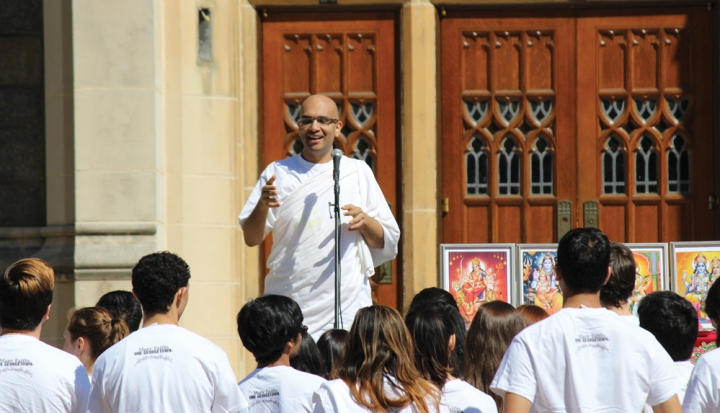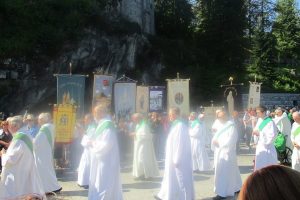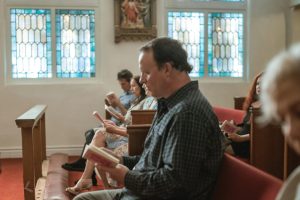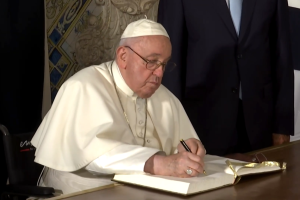While living at a monastery in India, Brahmachari Vrajvihari Sharan took turns cooking meals for 150 people. So when he became a chaplain at Georgetown this past school year, the Hindu monk priest knew how to stretch the allotted budget for hosting his “Free Food Friday” open houses on his New South Hall floor.
Sharan says his Friday open houses, where he serves seasonal, organic vegetarian snacks, are not as legendary as the Thursday night “Brownies and Quesadilla” ones hosted by Jesuit Father Chris Steck, who is the longtime Jesuit-in-residence living on the floor above him in the same dorm. But the goals of the two men, as well as that of the other Georgetown chaplains-in-residence, are the same: to serve all students at Georgetown, whatever their faith.
“We are mindful of being present to all the students, making sure they have someone else to bounce their ideas off of, cognizant of the fact that a lot of their information comes from their peers,” Sharan says. The food socials are a hook to show that chaplains are nonjudgmental sounding boards always available to students.
A chaplain for all
When he was hired in 2016, Sharan became the first Hindu priest to serve as a chaplain at a U.S. university. He says it shows that Georgetown is Catholic in its roots but prioritizes supporting students from all faiths. There are Jewish, Protestant, Muslim, and interreligious chaplains on the campus ministry staff and a diverse range of chaplains-in-residence.
That diversity reflects a national trend toward multifaith chaplaincies and religious life offices at U.S. universities.
“You’re starting to see even smaller schools with modest resources trying to figure out a way to offer something to their students that are coming from . . . minority religious populations,” says Sharon Kugler, who is the first female, first Catholic, and first lay chaplain at historically Protestant Yale University.
The tricky part often is figuring out which religions get a chaplain, religious dean, or other leader on campus to represent them.
“I think that none of us have cracked the nut of how to be sure that everyone’s traditions are represented and valued,” says Rabbi Patricia Karlin-Neumann, the senior associate dean for religious life at Stanford University. “At what point do you say there’s a critical mass and they need to be served?”
At Georgetown that critical mass happens when the campus ministry team sees enough active students of a particular faith that it makes sense to bring on a staff member to support them. It has a rabbi on staff for the Jewish community, it was the first American university to hire a full-time Muslim chaplain, and Sharan became its first Hindu Life director in summer 2016.
“Anytime I walk into a meeting it’s like walking into a joke because in front of me sat the rabbi, the imam, the priest,” Sharan says.
As a Hindu monk priest and a scholar of South Asian studies, Sharan has an extensive background in Eastern meditation practices. So he’s found that many students come to him curious about meditation or looking for specific ways to add contemplative practices to their life.
He’s happy to offer guidance, whether it’s on his own Hindu meditation practices or other forms he thinks students would relate to. For instance, he has pointed some Catholic students to the Jesuit Daily Examen, a spiritual examination of one’s day.
Many students came back later to tell him the various meditation techniques had an impact and “gave them 15 minutes a day where they could just center themselves and give themselves a good orientation for work,” Sharan says.
Sharan says that widespread hiring of Hindu chaplains at U.S. universities is probably at least half a decade away. “But I think it’s more important that Hindus take up chaplaincy not for the sake of becoming the Hindu chaplain but for becoming a chaplain on a team,” he adds.
For recent Yale graduate Raymond Mejico, chaplaincy is also less about having a chaplain for his Catholic faith and more about knowing there is a place on campus that supports all students.
Mejico first noticed the chaplain’s office on a freshman orientation tour and felt like it was “a safe space for religion.” He soon got a campus job there and kept it throughout his undergraduate studies.
Mejico says that he soon came to view the chaplaincy staff as parent figures. “My family was on the West Coast,” he says “[Members of the Yale chaplaincy staff] were making sure I had gloves in the winter, things like that.”
The chaplain’s office reminded Mejico a bit of the campus ministry program at his Catholic high school alma mater back in Los Angeles, but with a wider mission of supporting all religions.
“It’s a very welcoming space for everybody,” he says. “I was exposed to so many different faith traditions in a way that I don’t think I would have ever been at a Catholic school.”
Mejico also joined the InterFaith Forum at Yale. Kugler and an associate chaplain facilitate the group, which brings students of various faiths together for a regular Monday night dinner, discussion, and activity.
Other Yale chaplaincy strategies for reaching out to students are a bouncy castle that travels around campus and an ice cream cooler outside Kugler’s office that’s restocked weekly. Kugler hosts regular “Cookies and Coloring with the Chaplain” events in a technology-free space, and late night coffeehouses allow her staff to connect with students in a casual way.
“Chaplaincy facilitates getting to know ‘the other’ in a very safe and warm place,” Mejico says.
Out of the chapel
The model of chaplaincy as facilitating interfaith community is relatively new. In the Midwest and East Coast the first college chaplains were clergymen of whatever denomination founded the university. Their Sunday services were the centerpiece of campus religious life, says Kugler, who also teaches a class on university chaplaincy at Yale Divinity School.
Out West, where universities were less likely to have been founded by one religion, there weren’t as many chaplains, says the Rev. Janet Cooper Nelson, Brown University’s chaplain.
But by the 1960s and ’70s, chaplaincies were no longer about just officiating over religious services. Student activism and social justice work became part of the job, and “people saw not only the chaplain as a person in the pulpit but also as a person in the public,” Kugler says.
By the time Kugler became the chaplain at Johns Hopkins University in 1993, she says, “What I was discovering was how religiously diverse the college campus was becoming. And that was reflective of institutions across the country.”
Universities began to hire associate chaplains to support more religious denominations on campus. For instance, within a few years of Brown University hiring its first Muslim chaplain in 2004, the number of Muslim college chaplains across the United States rose from just a few to more than 30, according to Cooper Nelson, the Brown University chaplain.
At Johns Hopkins, Kugler began regular listening circles where students of different faiths would share with each other about their beliefs. She held similar gatherings for religious leaders. She wanted to offer radical hospitality under a servant leader model. At conferences, chaplains across the United States discussed how they could make chaplaincy about creating community.
Today, while Kugler still hosts an interfaith discussion circle at Yale, she thinks students know much more about other religions than they once did. More students today come from multifaith homes or will end up marrying someone of a different faith.
“I also find that they come to the circle really wanting to talk about the world and how they are to be in it,” she says.
Recent Brown graduate Louisa Conwill was raised in a fairly conservative Catholic home. In college she was active in the Brown-RISD Catholic Community, leading Bible studies and serving on the pastoral council.
But interfaith dialogue also captivated her. A Thursday night interfaith supper at the chaplain’s home her freshman year introduced her to chaplaincy at Brown. And she has since participated in a chaplain’s office interfaith panel, sharing her Catholic experience.
Conwill says that most students at Brown know the chaplain’s office as a place to go if they are struggling. You can get informal counseling if you’re not comfortable going to the larger counseling center on campus or receive emergency funds.
“Students who have a religious identity know it as the central place from which all the other religious communities branch off from,” she says.
It was through a connection with the chaplain’s office that Conwill participated in and later helped organize the Avi Schaefer Interfaith Shabbat. The event, which started out primarily as a Hillel effort, has added more interfaith elements in the last two years.
It starts with a Jummu’ah prayer service at the Muslim student center followed by a Shabbat service, dinner, and tisch (gathering with storytelling and food) at Hillel on Friday night. On Saturday there is an interfaith service and more food. And on Sunday the Catholic and Islamic centers invite guests to attend their services.
Conwill especially loves the Friday night tisch. Students from a mix of religions gather in an upper room at Hillel, sitting in a loose circle, eating ice cream, sharing how they live out their faith, and finding commonalities and understanding between them.
At the tisch her sophomore year, Conwill shared how her family didn’t eat meat on any Fridays of the year, not just during Lent. A Jewish student said she could relate that to her own practice of keeping kosher.
“It was really validating to me to go to the interfaith Shabbat and talk to people of other faiths and learn that they had similar religious experiences to me even if they were a part of a different faith group and had different beliefs and practices,” she says. “Just the fact that they also had a religious practice at a very secular campus made us bond. That was a really powerful experience for me.”
A ministry of many hats
At the same time that many universities are moving to a multifaith chaplaincy program, the Rev. Cooper Nelson points out that “religious life ought to in some way mirror the demographics of the campus.”
Part of a chaplain’s role can be vetting various groups looking to join a university’s religious life umbrella and decide if they fit the needs of the student body. Another chaplaincy difficulty can be covering all the intricacies of any one faith. There are many forms of Buddhism, for instance, so how do you represent that diversity?
“What we try to do is be comfortable with the chaos,” Kugler says. “I kind of act like the fairy godmother just trying to pay attention to what I think [each faith’s] needs are and see if we can make the magic happen.”
One thing that unifies all chaplains and deans or directors of religious life is how atypical their workdays are.
Besides being a chaplain-in-residence and living in one of the dorms on campus, Sharan performs Sunday services, teaches in Georgetown’s theology department, and regularly offers pastoral counseling to students. He has shown White House representatives around campus, promoted interfaith initiatives, and consulted regularly with other university Hindu chaplains about developing that subset of chaplaincy.
As one of three deans of religious life at Stanford, Rabbi Karlin-Neumann is responsible for supporting students of all faiths on campus, not only the Jewish population. She regularly preaches at the university’s public Sunday services. She teaches classes and noncredit study groups. She officiates at baby-naming ceremonies and welcomes families to the university. And she is active at the Haas Center of Public Service, where she aims to give a religious voice to social justice and service work. Like many chaplains and religious leaders, Karlin-Neumann also presides at weddings and funerals.
“I think it helps us to be seen as not your grandmother’s rabbi or not your grandmother’s priest,” she says.
Many fruitful relationships with students have come out of her work. In particular she recalls a young woman in a grief and bereavement group she led. The student’s brother died in a traffic accident right before she started college. The young woman became a fixture in the grief group throughout her undergraduate and graduate studies at Stanford, and she formed a close connection with Karlin-Neumann.
So when the Stanford grad got engaged to her college sweetheart, she asked the rabbi to preside at their wedding ceremony, though neither she nor her fiancé are Jewish.
Karlin-Neumann read from the psalms (“You turn my mourning into dancing”) at their wedding and told those gathered, “We’re not bound together by a specific religious tradition. We’re bound together by our shared humanity and the experience of suffering.”
Student-centered
In a high-stress environment like higher education where students can feel pressure to be perfect, Karlin-Neumann feels that religious life offices are key support networks.
“Part of what religious communities can help students to do is to see a different way of evaluating worth and to kind of remember the virtues that so easily get lost in a high-powered place,” she says.
University chaplains, she says, help set students up to be religiously well-versed and accepting members of society. And if you aren’t religious, “you still need a basic fluency or literacy in religion.”
When people generalize about young adults and their lack of faith or religious practice, Kugler can’t entirely relate.
“What people speculate about this generation has not been my experience of them,” she says. “The old way we used to count [engagement] was by how many people were in the pews. I think that that doesn’t tell us much anymore.”
Kugler would rather gauge young adult faith levels firsthand, like she did this past school year on the chaplain’s office spring break trip to Washington, D.C.
Every year, staff take a small group of second-year students on a weeklong trip to immerse themselves in the practices of different faiths. Among the places they visited in 2017 were a Sikh gurdwara, a Turkish mosque, a Hindu temple, a Cambodian Buddhist temple, a Jain religious community, and a synagogue. They also served at a large soup kitchen near the Capitol, did other community service projects, and visited the Holocaust museum.
The trip’s goal is to allow students to “experience a kind of radical hospitality in a setting they may not have ever been in” and to learn about themselves through the conversations they have with each faith community, Kugler says.
Mejico made the D.C. trip in 2016 and liked the mix of experiencing religious sites and service work. “The coolest part for me was visiting the Sikh gurdwara,” he says. Sitting cross-legged on the ground while gurdwara members brought round after round of food out to complete strangers who were peppering them with questions that they happily answered, Mejico says he realized, “I don’t think I’d ever really experienced such immediate, open, warm hospitality.”
After the spring break trip, participants act as Chaplaincy Fellows to students the following school year, holding study sessions at the chaplain’s office or just hanging out, drinking tea, eating Go-Gurts, and chatting, says Mejico.
“I have the privilege of watching these students as the week unfolds just become transformed by their experience,” Kugler says. “I’m so grateful I had the chance to do it and will do it again. Because, again, they are teaching me something.”
Sharan too finds the energy of young adults to be one of the greatest things about working with them.
“It’s nice to spend time with this age group because they’re always very dynamic and open to new ideas,” he says. “Even if they are set in certain ideas they are able to listen to criticism without feeling directly attacked.”
Sure, there are “growing up” issues relating to their age and emotional maturity. But that makes a chaplain’s role all the more important, he says.
“People grow spiritually throughout the entire course of their lives. But it’s the crucial years around university that dictates not only the beginning of your career but also how fixed you are in your morals and your ethics.
“And it’s always great to have resources available for them, to bounce ideas off people who are themselves grounded in a tradition that has a very longstanding, far-reaching understanding of what morals and ethics are to their particular faith group,” Sharan says.
As the Georgetown school year wrapped up in May, Sharan says it was heartening to see the number of students looking for him before they left campus.
“Other Hindu families were very surprised to see the number of non-Hindu families who would search me out just to say a fond goodbye,” he says. That’s a testament he thinks to his being “first and foremost a chaplain,” not just a Hindu chaplain, in the eyes of students.
“More people need to get involved in studying and researching and actually becoming chaplains,” he says. “And more universities need to consider the role . . . and the effect of having a chaplain on campus. Although it may seem at the beginning like a small enterprise, the results are wide felt.”
This article also appears in the September 2017 issue of U.S. Catholic (Vol. 82, No. 9, pages 12–17).
Image: Students of the Georgetown University Hindu Student Association














Add comment